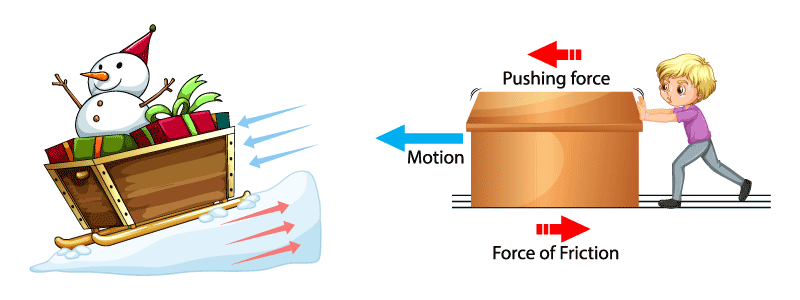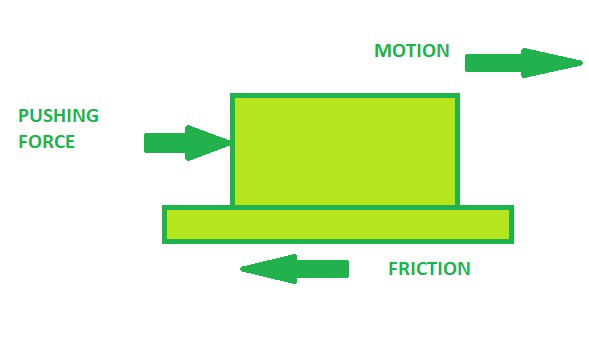

CBSE Class 8 Science Notes Chapter 9: Here are the notes for CBSE Class 8 Science Chapter 9 Friction, which are beneficial for students preparing for Class 10 exams. This chapter covers the concept of friction, a force that resists the movement of objects sliding or rolling against each other.
The notes also discuss practical applications of friction and how it can be managed in various situations. These insights are valuable for understanding the fundamental principles of friction and its role in everyday life.CBSE Class 8 Science Notes Chapter 9 Friction Overview
These notes are prepared by the subject experts of Physics Wallah for CBSE Class 8 Science Chapter 9 Friction. They provide a detailed overview of the concept of friction, including its types static, kinetic, and rolling friction. The notes explain how friction works, its effects on objects in motion, and its practical applications in everyday life. By using clear explanations and examples, these notes help students understand the role of friction in various scenarios and its importance in both science and daily activities.CBSE Class 8 Science Notes Chapter 9 Friction PDF Download
The PDF link for CBSE Class 8 Science Notes Chapter 9 Friction is available below. This PDF provides a detailed overview of the chapter, covering essential concepts and examples related to friction. It includes explanations of different types of friction, their effects, and practical applications. Students can use this PDF to enhance their understanding and review key points from the chapter effectively.CBSE Class 8 Science Notes Chapter 9 Friction PDF
CBSE Class 8 Science Notes Chapter 9 Friction
Below we have provided CBSE Class 8 Science Notes Chapter 9 Friction for students to help them understand the chapter better and to score good marks in their examination.What is Friction?
 Friction is the external force that opposes the relative motion between two surfaces in contact. It acts along the surface where the two bodies make contact, resisting their movement.
For example, when you slide a book across a table, friction acts between the book and the table, slowing down its movement. Friction is important in everyday life as it provides the necessary grip to walk, drive, and handle objects safely.
Friction is the external force that opposes the relative motion between two surfaces in contact. It acts along the surface where the two bodies make contact, resisting their movement.
For example, when you slide a book across a table, friction acts between the book and the table, slowing down its movement. Friction is important in everyday life as it provides the necessary grip to walk, drive, and handle objects safely.
Relative Motion
 Relative motion refers to the movement of an object as observed from a particular reference point or frame of reference. Essentially, it describes how the position of one object changes concerning another object. This concept is crucial in understanding how and why objects appear to move differently depending on the observer’s perspective.
Relative motion refers to the movement of an object as observed from a particular reference point or frame of reference. Essentially, it describes how the position of one object changes concerning another object. This concept is crucial in understanding how and why objects appear to move differently depending on the observer’s perspective.
Why Friction?
Friction is a force that opposes the relative motion between two surfaces in contact. It arises from several factors:Surface Irregularities:
- Cause: All surfaces, even those that appear smooth, have tiny irregularities and rough patches. When two surfaces come into contact, these irregularities interlock, creating resistance against movement.
- Effect: This interlocking of surface textures causes friction, which acts to prevent or slow down the relative motion between the surfaces.
Adhesive Forces:
- Cause: When two materials are in contact, microscopic attractive forces between their molecules or atoms contribute to friction. These adhesive forces create a kind of "stickiness" that resists movement.
- Effect: Adhesive forces between the surfaces increase the overall resistance to motion, making it harder for the surfaces to slide past each other.
Plowing Effect:
- Cause: This effect occurs when one surface (often rough or uneven) plows through or scrapes along another surface. The irregularities on the surface can create a plowing action that adds to the resistance.
- Effect: This effect increases friction by forcing the surface to move through or displace material from the other surface, adding additional resistance to the motion.
Surface Irregularities and Adhesive Forces
Surface Irregularities:
- Description: At a microscopic level, every surface is not perfectly smooth. Instead, surfaces contain numerous tiny hills and valleys. These microscopic irregularities are what create friction when two surfaces come into contact.
- Impact: When two surfaces rub against each other, the irregularities interlock or catch on each other. This interlocking creates resistance to motion. Rough surfaces have larger and more pronounced irregularities, leading to higher friction. Conversely, smoother surfaces have fewer irregularities, resulting in lower friction.
Adhesive Forces:
- Description: Adhesive forces occur when two surfaces are in contact and form bonds at the microscopic level. This bond creates a "stickiness" between the surfaces, known as adhesion.
- Impact: When trying to move objects resting on each other, you must overcome these adhesive forces. This means breaking the bonds formed between the surfaces. The greater the adhesive forces, the harder it is to move the objects, leading to increased friction.
Factors Affecting Friction

Nature of the Surfaces in Contact:
- Surface Texture: Rough surfaces create more friction due to greater surface irregularities that interlock more strongly, increasing resistance. For example, sandpaper has a rough texture, resulting in high friction, while smooth surfaces like polished metal create less friction.
- Material Type: Different materials have varying levels of friction. For instance, rubber on asphalt provides more friction than rubber on ice. The nature of the materials influences the amount of friction experienced.
Normal Reaction Force:
- The normal reaction force is the force applied perpendicular to the surfaces in contact. It is directly proportional to the amount of friction. A higher normal force increases the frictional force because the surfaces are pressed together more firmly, enhancing the interaction between them. For example, pressing down harder on an object increases the friction between the object and the surface it is on.
Surface Area in Contact:
- Contrary to common belief, the frictional force is not significantly affected by the contact area when the normal force is constant. Friction primarily depends on the nature of the surfaces and the normal reaction force, not on how much area is in contact. For instance, whether you slide a small or large block of the same material across a surface, the frictional force remains similar if the weight is the same.
Presence of Lubricants:
- Lubricants such as oil or grease reduce friction by creating a layer between the surfaces in contact. This layer minimizes direct contact between the surfaces, thus reducing friction. For example, applying oil to a machine's moving parts can decrease friction and prevent wear and tear.
Condition of the Surfaces:
- The condition of the surfaces, such as whether they are clean or dirty, can affect friction. Dirt, dust, or other contaminants can alter the texture and increase friction. For instance, a dusty road surface will have more friction than a clean, paved road.
Friction: A Frenemy?
How Does Friction Produce Heat?
Friction is often referred to as a "frenemy" because, while it is beneficial in many scenarios, it can also be problematic. One of the key ways friction is both helpful and problematic is through heat production. Here's how it works:- Breaking Bonds: When two surfaces rub against each other, friction causes the microscopic bonds between their particles to break. This process requires energy.
- Particle Vibration: As these bonds break, the particles in the surfaces start to vibrate more rapidly. This increased vibration of particles translates to an increase in kinetic energy.
- Heat Generation: The increased kinetic energy manifests as heat. Therefore, friction turns mechanical energy into thermal energy, raising the temperature of the surfaces involved.
Applications of Friction
Friction is integral to many everyday activities and technologies:- Writing: The friction between the pen or pencil and paper allows us to leave a mark. Without this friction, writing would be impossible.
- Walking and Running: Friction between our shoes and the ground prevents us from slipping, enabling us to walk and run effectively.
- Tyres on a Car: The friction between car tyres and the road surface provides the necessary grip for controlling the vehicle, especially during acceleration, braking, and turning.
- Nail Sticking to the Wall: Friction between the nail and the wall helps the nail stay in place, securing items to surfaces.
- Matchsticks: The friction between a matchstick's head and the striking surface creates enough heat to ignite the chemicals and start a fire.
Reinvent the Wheel
Rolling and Using Treads to Change Friction
Understanding and manipulating friction is crucial for enhancing performance and efficiency in various applications. Here’s how rolling and treads play a role:Rolling Friction vs. Sliding Friction: Rolling friction is generally much less than sliding friction. This is because, in rolling, only a small area of the surface is in contact with the ground at any time, compared to sliding, which involves more surface area and greater resistance. This principle is why rolling is often preferred in many machines and vehicles. For instance, ball bearings are used in machinery to reduce friction by allowing parts to roll rather than slide.
Ball Bearings: Ball bearings reduce friction between moving parts by facilitating rolling motion instead of sliding. This significantly decreases the resistance and wear on components, leading to smoother operation and increased efficiency.
Treads on Tyres: Tyres with treads are designed to enhance friction with the road surface. The treads help to expel water and increase grip, especially in wet conditions. This improved friction is essential for safety and control of vehicles.
Skydiving Cat: Understanding Drag Force
Drag Force: Drag is a type of frictional force exerted by fluids (such as air or water) on an object moving through them. It opposes the motion of the object and acts in the direction opposite to its movement.
Factors Affecting Drag Force: The magnitude of drag force depends on several factors:
- Speed: The faster an object moves through a fluid, the greater the drag force.
- Shape of the Body: Streamlined shapes experience less drag compared to bulky or irregular shapes, as they allow smoother flow of the fluid around them.
- Nature of the Fluid: The density and viscosity of the fluid also affect the drag force. For example, an object moving through water experiences more drag than the same object moving through air.
Benefits of CBSE Class 8 Science Notes Chapter 9
- Enhanced Understanding: These notes provide a clear and comprehensive explanation of friction, including its types, causes, and effects. Understanding these concepts helps students grasp the fundamental principles of how friction influences everyday activities and machinery.
- Simplified Learning: The notes break down complex topics into simple language and easy-to-understand sections. This makes it easier for students to absorb and retain key concepts related to friction and its applications.
- Exam Preparation: With well-organized content, these notes are an excellent resource for students preparing for exams. They cover important topics and concepts in Chapter 9, ensuring that students are well-prepared for questions on friction and related phenomena.
- Practical Applications: The notes include real-life examples and applications of friction, such as the role of friction in writing, walking, and using vehicles. This helps students connect theoretical knowledge with practical situations, enhancing their understanding of the subject.
- Study Efficiency: By summarizing key points and providing concise explanations, these notes help students study efficiently. They offer a focused review of Chapter 9, allowing students to quickly revise important concepts and reinforce their learning.
CBSE Class 8 Science Notes Chapter 9 FAQs
What is friction?
How is friction measured?
What is rolling friction and how does it differ from sliding friction?
What is drag force?
How does friction produce heat?











